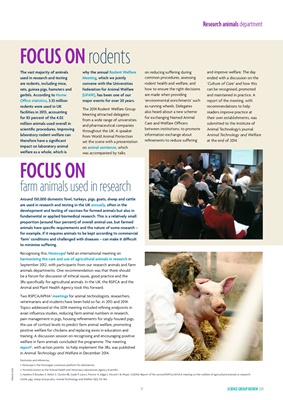
19 SCIENCE GROUP REVIEW 2014
Research animals department
FOCUS ON rodentsThe vast majority of animals
used in research and testing
are rodents, including mice,
rats, guinea pigs, hamsters and
gerbils. According to Home
Office statistics, 3.33 million
rodents were used in UK
facilities in 2013, accounting
for 83 percent of the 4.02
million animals used overall in
scientific procedures. Improving
laboratory rodent welfare can
therefore have a significant
impact on laboratory animal
welfare as a whole, which is
why the annual Rodent Welfare
Meeting, which we jointly
convene with the Universities
Federation for Animal Welfare
(UFAW), has been one of our
major events for over 20 years.
The 2014 Rodent Welfare Group
Meeting attracted delegates
from a wide range of universities
and pharmaceutical companies
throughout the UK. A speaker
from World Animal Protection
set the scene with a presentation
on animal sentience, which
was accompanied by talks
on reducing suffering during
common procedures, assessing
rodent health and welfare, and
how to ensure the right decisions
are made when providing
'environmental enrichments' such
as running wheels. Delegates
also heard about a new scheme
for exchanging Named Animal
Care and Welfare Officers
between institutions, to promote
information exchange about
refinements to reduce suffering
and improve welfare. The day
ended with a discussion on the
'Culture of Care' and how this
can be recognised, promoted
and maintained in practice. A
report of the meeting, with
recommendations to help
readers improve practice at
their own establishments, was
submitted to the Institute of
Animal Technology's journal
Animal Technology and Welfare
at the end of 2014.
FOCUS ON
farm animals used in research
Around 150,000 domestic fowl, turkeys, pigs, goats, sheep and cattle
are used in research and testing in the UK annually, often in the
development and testing of vaccines for farmed animals but also in
fundamental or applied biomedical research. This is a relatively small
proportion (around four percent) of overall animal use, but farmed
animals have specific requirements and the nature of some research -
for example, if it requires animals to be kept according to commercial
'farm' conditions and challenged with diseases - can make it difficult
to minimise suffering.
Recognising this, Norecopa1 held an international meeting on
harmonising the care and use of agricultural animals in research in
September 2012, with participants from our research animals and farm
animals departments. One recommendation was that there should
be a forum for discussion of ethical issues, good practice and the
3Rs specifically for agricultural animals. In the UK, the RSPCA and the
Animal and Plant Health Agency took this forward.
Two RSPCA/APHA2 meetings for animal technologists, researchers,
veterinarians and students have been held so far, in 2013 and 2014.
Topics addressed at the 2014 meeting included refining endpoints in
avian influenza studies, reducing farm animal numbers in research,
pain management in pigs, housing refinements for singly housed pigs,
the use of cortisol levels to predict farm animal welfare, promoting
positive welfare for chickens and replacing ewes in education and
training. A discussion session on recognising and encouraging positive
welfare in farm animals concluded the programme. The meeting
report3, with action points to help implement the 3Rs, was published
in Animal Technology and Welfare in December 2014.
Footnotes and references:
1. Norecopa is the Norwegian consensus-platform for alternatives.
2. Formerly known as the 'Animal Health and Veterinary Laboratories Agency Scientific'.
3. Hawkins P, Brookes S, Parkin S, Clutton RE, Gade P, Lane J, Proctor H, Edgar J, Vincent I & Weyer U (2014). Report of the second RSPCA/AHVLA meeting on the welfare of agricultural animals in research:
Cattle, pigs, sheep and poultry. Animal Technology and Welfare 13(2): 155-164.
istock.com